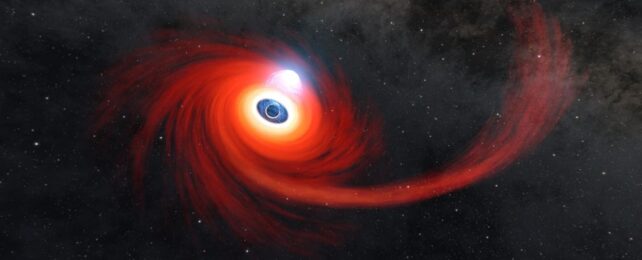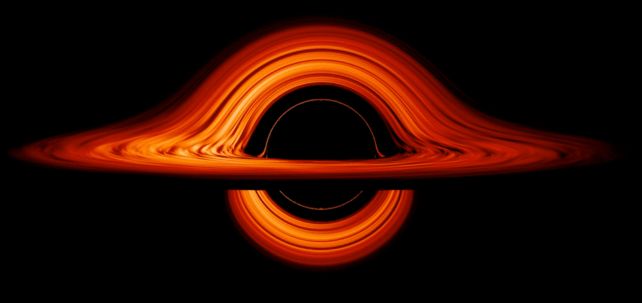
Astronomers have recently observed an extraordinary occurrence in the farthest regions of the observable Universe—a supermassive black hole bursting into activity. This remarkable event, detected as an intense luminous display originating from 10 billion years ago, indicates that the compact entity swiftly commenced devouring massive quantities of matter. Scientists assert that this incident represents one of the most astonishing instances of such an event ever witnessed.
The findings of this discovery were unveiled by a team led by astronomer Samantha Oates from the University of Birmingham in the United Kingdom at the annual National Astronomy Meeting. Additionally, the research will be published in the Monthly Notices of the Royal Astronomical Society and is currently accessible on the preprint server arXiv. The episode of intense brightness has been assigned the name J221951-484240, or simply J221951.
Astrophysicist Matt Nicholl from Queens University Belfast in Ireland remarks, "Our comprehension of the diverse behaviors exhibited by supermassive black holes has significantly expanded in recent years, encompassing the discoveries of stars being torn apart and the existence of accreting black holes with tremendously variable luminosity. J221951 stands as one of the most exceptional cases to date of a black hole catching us off guard."

Deep within each galaxy lies an enormous black hole, yet their activity levels are not constant. Some, like Sagittarius A* at the heart of our Milky Way, remain relatively tranquil due to a scarcity of surrounding matter available for consumption.
Nevertheless, the behavior of supermassive black holes fluctuates on cosmic timescales, transitioning between periods of dormancy and activation when sufficient material becomes accessible.
While initially searching for a distinct type of temporary surge called a kilonova event—a result of merging neutron stars—Oates and her team stumbled upon the enigmatic J221951. Although the signal emitted by J221951 exhibited the correct color, its duration differed significantly. Unlike kilonovae, which fade after a few days, J221951 persisted for a considerably longer period.
Upon closer examination, the researchers made a startling revelation: the light had traveled a much greater distance than initially presumed—10 billion years instead of 500 million. Consequently, they traced the flare's origin to the core of a galaxy situated at that precise location in space and time.
This newfound insight also indicated that the flare possessed an extraordinary luminosity, which corresponded not to a solitary explosion but to the continuous radiance generated by matter swirling around the extreme environs surrounding a supermassive black hole as it engulfs the material falling into it.
The abruptness of the flare, coupled with its remarkable brightness, further suggested that the black hole had instantaneously embarked on a feeding frenzy, devouring vast amounts of matter and transitioning from a dormant state to an intensely active one.
Two potential explanations exist for this intriguing phenomenon. The first possibility is that the black hole initiated its feeding process by devouring material swirling within a disk that had finally drawn near enough for the black hole to consume, transforming it into an active galactic nucleus. The second explanation involves a more violent event, wherein a star ventured too close to the black hole, resulting in its destruction and subsequent accretion—an occurrence referred to as a tidal disruption event.
To determine which hypothesis holds greater validity, further observations are required. "In the future, we will gather crucial evidence to differentiate between the tidal disruption event and active galactic nuclei scenarios," asserts Oates. She elaborates, "For instance, if J221951 is associated with the activation of an active galactic nucleus, we might anticipate a cessation of fading and a subsequent increase in brightness. Conversely, if J221951 is a tidal disruption event, we would expect its luminosity to continue to diminish. Monitoring J221951's behavior in the coming months to years is essential to capturing its late-stage characteristics."
The research findings will be documented in the Monthly Notices of the Royal Astronomical Society and are presently accessible on arXiv, allowing the scientific community to delve into this captivating discovery.





No comments:
Post a Comment